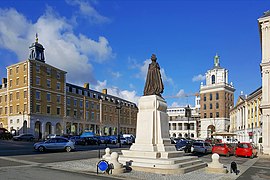
New Classical architecture
New Classical architecture, New Classicism or Contemporary Classical architecture[1] is a contemporary movement in architecture that continues the practice of Classical architecture. It is sometimes considered the modern continuation of Neoclassical architecture,[2][3][4] even though other styles might be cited as well, such as Gothic, Baroque, Renaissance or even non-Western styles[5] – often referenced and recreated from a postmodern perspective as opposed to being strict revival styles.[6]
This article is about the contemporary movement. For the historical style, see Neoclassical architecture.The design and construction of buildings in ever-evolving classical styles continued throughout the 20th and 21st centuries, even as modernist and other non-classical theories broke with the classical language of architecture. The new classical movement is also connected to a surge in new traditional architecture, that is crafted according to local building traditions and materials.[7]
While most universities worldwide teach modernist design principles, some institutions teach (solely, mainly, or partly) the principles of traditional and classical architecture and urban planning. Some of these are:[39]








